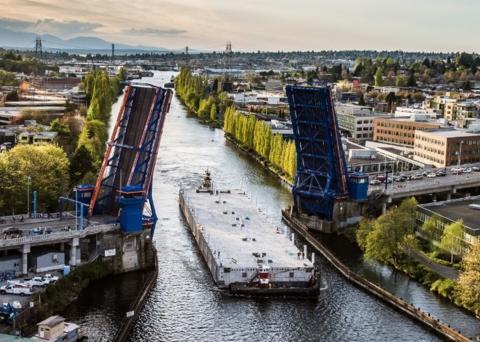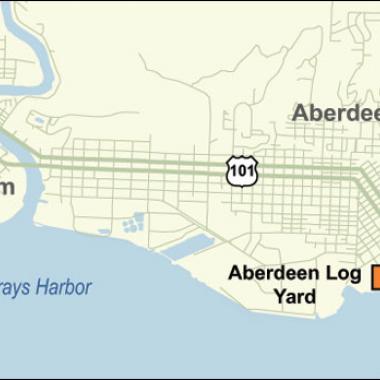Project overview
The SR 520 floating bridge is supported and stabilized by 77 concrete pontoons . The Pontoon Construction Project built a casting basin and 33 of the bridge’s pontoons in Aberdeen, Washington. We built 44 of the bridge’s smaller pontoons in Tacoma, Washington, as part of the Floating Bridge and Landings Project.
What to expect
The pontoons constructed for this project now support the new SR 520 Floating Bridge. SR 520 travelers now have a safer, higher-capacity bridge with new, dedicated HOV/transit lanes and a 14-foot-wide bicycle and pedestrian path.
Location of the former WSDOT pontoon casting basin in Aberdeen, Washington.
Bridge pontoons are large, watertight concrete structures and the foundation of a floating bridge. Though the pontoons are composed of heavy concrete, science allows the bridge to float! This is because the weight of the water displaced by the pontoons is equal to the bridge’s weight, including traffic.
WSDOT and contractor Kiewit-General built a 4-acre casting-basin facility in Aberdeen to stage construction of pontoons for the new SR 520 floating bridge. The 21 longitudinal pontoons built in Aberdeen – the largest ever built in the state - were joined end-to-end on Lake Washington. Each of these pontoons is 360 feet long, 75 feet wide, nearly 30 feet tall and weighs 11,000 tons.
Crews constructed the Aberdeen-built pontoons in six cycles. Each cycle of pontoons was floated out of the casting basin, inspected, and then towed by tugs into Lake Washington. We built an additional 44, smaller pontoons in Tacoma, Washington, that flank the larger, longitudinal pontoons and add supplemental stability for the new bridge. At the peak of construction, more than 650 workers – steelworkers, carpenters, concrete specialists, welders, crane operators and others – were on the job building pontoons between the two locations.
Learn more about the pontoons by reading our online SR 520 Floating Bridge booklet (PDF 6.8MB)
This project was an important part of the larger, ongoing megaprogram that is reconstructing the SR 520 corridor from I-405 in Bellevue to I-5 in Seattle. Completed phases of the larger SR 520 Bridge Replacement and HOV Program involved:
- The Floating Bridge and Landings Project, which built the world’s longest floating bridge on Lake Washington between Seattle and the Eastside, and also built 44 bridge pontoons in Tacoma.
- The Eastside Transit and HOV Project, which rebuilt the highway’s Eastside segment between I-405 and Lake Washington’s east shore.
- The West Approach Bridge North Project, which completed the first of two parallel west approach bridges over Union Bay, between the floating bridge and Seattle’s Montlake neighborhood.
- The Montlake Project, currently under construction, is completing the second of two parallel west approach bridges over Union Bay. This project also is building a new landscaped lid between Montlake Boulevard and 24th Avenue East, and a bicycle and pedestrian land bridge to the east of the lid.
When the corridor’s reconstruction is fully completed in the late 2020s:
- All of SR 520’s major bridges will be replaced with stronger structures.
- The bus/carpool lanes and a regional bicycle/pedestrian path will extend from Seattle east to Redmond.
- Travelers will have safer on-/off- ramps and improved connections to transit, local streets and the local and regional trail networks.

Tugboats guide a longitudinal pontoon through the Lake Washington Ship Canal and past the
Fremont Bridge en route to Lake Washington for assembly of the new SR 520 floating bridge.
Project benefits
- The pontoons built as part of this project form the basis of a safer and more reliable SR 520 floating bridge. The new bridge is designed to withstand sustained winds of 89 mph, or the equivalent of a 100-year storm.
- The new bridge eases congestion due to a wider, six-lane roadway with dedicated transit/HOV lanes, wider and safer shoulders and a 14-foot-wide bicycle/pedestrian path.
- The pontoon construction project created hundreds of local jobs and supported the local economy in and around Aberdeen through the purchase of supplies and supporting services.

